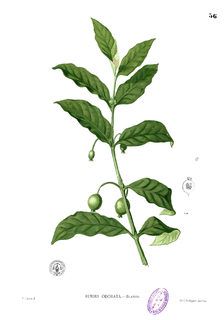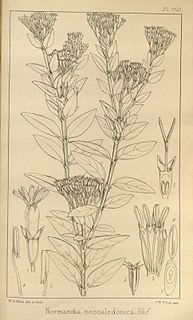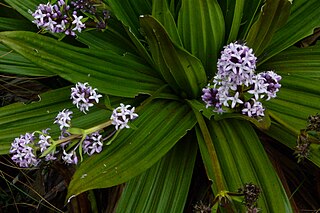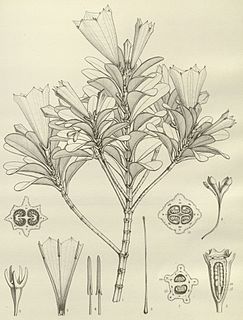
The Rubiaceae are a family of flowering plants, commonly known as the coffee, madder, or bedstraw family. It consists of terrestrial trees, shrubs, lianas, or herbs that are recognizable by simple, opposite leaves with interpetiolar stipules and sympetalous actinomorphic flowers. The family contains about 13,500 species in about 620 genera, which makes it the fourth-largest angiosperm family. Rubiaceae has a cosmopolitan distribution; however, the largest species diversity is concentrated in the tropics and subtropics. Economically important species include Coffea, the source of coffee, Cinchona, the source of the antimalarial alkaloid quinine, some dye plants, and ornamental cultivars.

Genipa is a genus of trees in the family Rubiaceae. This genus is native to the American tropical forests.

Manettia is a genus of flowering plants in the family Rubiaceae. There are between 80 and 123 species. They are distributed in the West Indies, Mexico, and Central and South America. Most are vines. The genus was named after Saverio Manetti.

Psychotria is a genus of flowering plants in the family Rubiaceae. It contains 1,582 species and is therefore one of the largest genera of flowering plants. The genus has a pantropical distribution and members of the genus are small understorey trees in tropical forests. Some species are endangered or facing extinction due to deforestation, especially species of central Africa and the Pacific.

Houstonia (bluet) is a genus of plants in the family Rubiaceae. Many species were formerly classified, along with other genera since segregated elsewhere, in a more inclusive genus Hedyotis.

Bertiera is a genus of flowering plants in the family Rubiaceae. It comprises 57 species with most known from tropical Africa, five known from various Indian Ocean islands and five found in the tropics of the Americas.

Randia, commonly known as indigoberry, is a mostly Neotropical genus of shrubs or small trees in the Rubiaceae. The International Plant Names Index (IPNI) lists a total of 738 names for the genus, synonyms included. Several Australian species have been reassigned to the genus Atractocarpus. These include the garden plants Atractocarpus chartaceus and A. fitzalanii.

Hedyotis (starviolet) is a genus of flowering plants in the family Rubiaceae. Many species of this genus such as Hedyotis biflora, H. corymbosa and H. diffusa are well known medicinal plants. Hedyotis is native to tropical and subtropical Asia and to islands of the northwest Pacific. It comprises about 115 species. The type species for the genus is Hedyotis fruticosa.

Normandia is a monotypic genus of flowering plants in the family Rubiaceae. It was described by Joseph Dalton Hooker in 1872. The genus contains only one species, Normandia neocaledonica, which is endemic to New Caledonia. The genus is related to Coprosma and Nertera.
Edrastima is a genus of flowering plants in the family Rubiaceae. The genus widespread and is found in Central and Eastern USA and the tropics and subtropics.
Exallage is a genus of flowering plants in the family Rubiaceae. The genus is found from tropical and subtropical Asia to the southwestern Pacific.
Cremaspora is a genus of flowering plants in the family Rubiaceae. It is the only genus in the tribe Cremasporeae. It was described by George Bentham in 1849. The genus is widespread across much of sub-Saharan Africa from Senegal to Tanzania and south to Mozambique and Zimbabwe, in addition to Madagascar, Comoros, and Cape Verde. There are, however, only two currently recognized species.

Hedyotis verticillaris is a plant belonging to the family Rubiaceae that is endemic to the higher altitude grasslands of the Nilgiris in southern India. Unlike many others members of the genus the stems of this species are underground and the leaves appear close to the ground forming rosettes and usually hold some water at the centre of the whorl of leaves. The flowers are produced on a stalk.

Spermacoceae is a tribe of flowering plants in the family Rubiaceae and contains about 1346 species in 57 genera. Its representatives are found in the tropics and subtropics.

Thiollierea is a genus of shrubs in the family Rubiaceae. The genus is endemic to New Caledonia in the Pacific and contains 14 species which used to be placed in the genera Bikkia or Morierina
Debia is a genus of flowering plants in the family Rubiaceae. The genus is found from the Indian subcontinent to south-central China and the Philippines.
Involucrella is a genus of flowering plants in the family Rubiaceae. The genus is found from Assam to Hainan and Peninsular Malaysia and the Philippines.
Leptopetalum is a genus of flowering plants in the family Rubiaceae. The genus is widespread in tropical and subtropical Asia and the Pacific.

Dr.Charlotte M. Taylor is a botanist and professor specialising in taxonomy and conservation. She works with the large plant family Rubiaceae, particularly found in the American tropics and in the tribes Palicoureeae and Psychotrieae. This plant family is an economically important group, as it includes plant species used to make coffee and quinine. Taylor also conducts work related to the floristics of Rubiaceae and morphological radiations of the group. Taylor has collected plant samples from many countries across the globe, including Chile, Colombia, Costa Rica, Panama, and the United States of America, and has named many new species known to science from these regions. As of 2015, Taylor has authored 278 land plant species' names, the seventh-highest number of such names authored by any female scientist.












